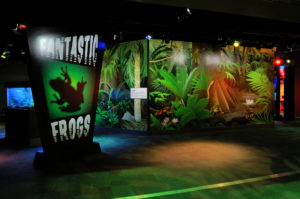 A special exhibition detailing the life and times of some of our favorite amphibians recently hopped back into Discovery Place Science. Fantastic Frogs, a 3,500-square-foot exhibition, is now on display at the Uptown museum for the at least the sixth time in its 10-year history.
A special exhibition detailing the life and times of some of our favorite amphibians recently hopped back into Discovery Place Science. Fantastic Frogs, a 3,500-square-foot exhibition, is now on display at the Uptown museum for the at least the sixth time in its 10-year history.
The popular exhibition engages visitors in learning about the “superpowers” frogs use to escape predators, catch food and reproduce. Taking a graphic novel approach, Fantastic Frogs includes approximately 40 live animals as well as several multimedia experiences.
“This is a story about extraordinary frogs and their ability to survive,” said Discovery Place’s Sarah Macey, who helped design the exhibition, which debuted in 2010. “It is a story focused on how these amphibians move, camouflage themselves, live in the winter months and more. Frogs have evolved incredible adaptations to survive over millions of years.
“We also pose a question about whether these amazing species will be able to continue to survive with the rate of human-induced climate change.”
A variety of frog species are on display as part of the exhibition, including the most poisonous amphibian (and perhaps animal!) in the world – the golden poison dart frog. Its bright coloring warns predators of its extreme toxicity, serving as its main protection and allowing the frog to have a relatively long lifespan in the wild.
In addition to various types of poison dart frogs, the exhibition also showcases such species as the tomato frog, the Pacman frog, a Vietnamese mossy frog, Solomon Island Leaf frog and harlequin toad to name a few.
“The exhibition is great for giving you a sense of what frog biodiversity looks like worldwide. We’ve got species from Africa, South America, Polynesia, Asia, Australia and North America,” said Elliot Provance, director of Living Collections at Discovery Place. “Frogs are remarkable survivors and have adapted to almost every habitat on earth. That being said, amphibians are a good indicator species to tell us about the health of an ecosystem. Inherently, amphibians rely on clean water and air to survive. When their numbers decline, something is wrong.”
The exhibition, which is free with the price of admission, is now on display. Discovery Place Science is open on Saturdays and Sundays, 9:30 a.m. to 4:30 p.m. Advance tickets are required and can be purchased by visiting www.discoveryplacescience.org.
